As an Amazon Associate I earn from qualifying purchases.
Lake Trout, A Complete Anglers Guide
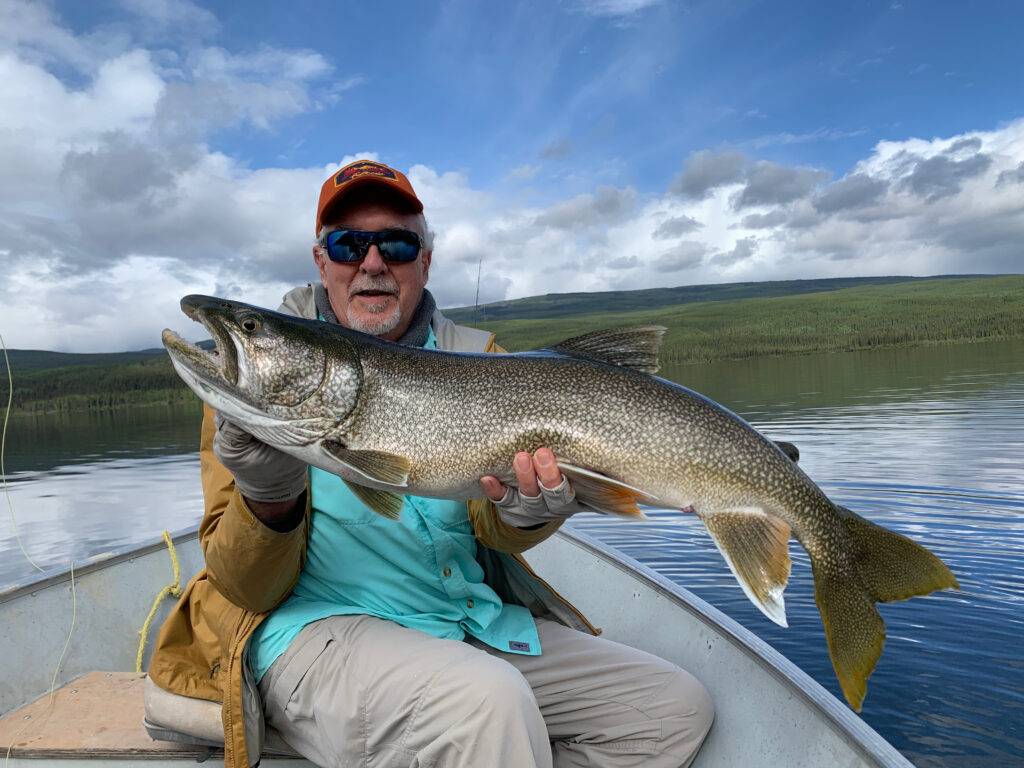
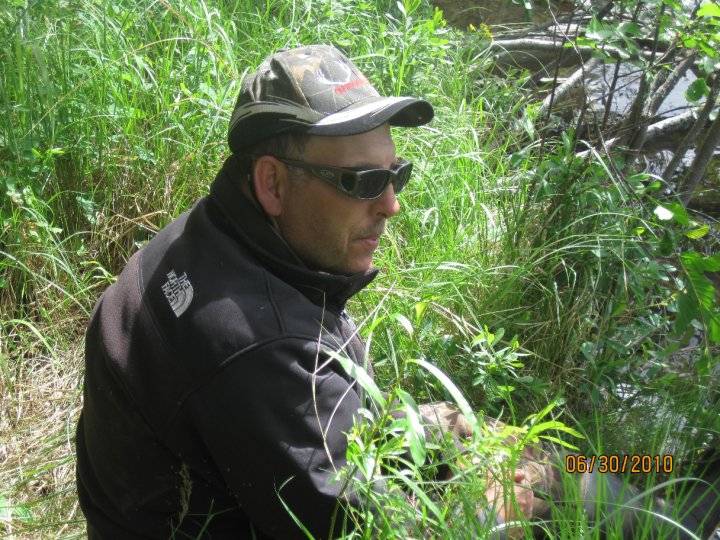
David O’Farrell started guiding anglers professionally in 1987 and has never looked back. Along with his wife, Reggie, they now own Grizzly Creek Lodge, where he first started guiding 36 years ago. David still spends every summer guiding anglers from all over the world. This post is for anglers. It is a comprehensive article that covers everything an angler needs to know about lake trout fishing. After 36 seasons on the water, David has a tremendous amount of experience to share about one of the most sought-after freshwater species.
This comprehensive guide contains everything an angler needs to know about lake trout
- Biology of lake trout
- What lake trout eat
- How to find and catch lake trout
- Proven catch-and-release methods
- Spinning Rods / Reels
- Baitcasting Rods/Reels
- Best spoons and deepwater baits
- How to find trout with Dardevle spoons
- Catch more trout with clear line
- Best Time to fly fish lake trout
- Tips on choosing a fly rod for lake trout
- Lake trout recipes
You might see product links on this page. They are our affiliate links and we will earn a small commission if you choose to purchase anything through them. If you do, we would like to thank you in advance; it helps us keep this site up and running. There is a lot of useless junk on the market today, but you can rest assured that we don’t promote anything we haven’t used ourselves. Tight lines, Dave & Reg
Lake trout are Native Only to North America
Lake trout are native only to North America but have been introduced all over the globe. This species is abundant in Canadian and Alaskan waters; more minor, localized populations are also present in the continental United States.
The rush lake trout( Salvelinus namaycush huronicus ) is the least common of the three subspecies of lake trout.
Siscowet lake trout ( Salvelinus namaycush siscowet ) and the common Lake trout ( Salvelinus namaycush ) are the largest members of the char family.
Their size, and stamina, make them one of the most popular freshwater game fish species. These fish can vary wildly in coloration, even in the same body of water. The heaviest lake trout caught with rod and reel weighed 72 pounds. This fish is the current IGFA all-tackle world record. There have also been credible reports of lake trout weighing over 100 pounds caught in gill nets.
Lake Trout Live Long Lives
An average lake trout will be 24 to 36 inches long and weigh around 10 to 12 pounds. There are length-to-weight ratios anglers can use that make it easy to estimate weight without using a scale. We encourage anglers to use the length-to-weight formula because weighing fish increases mortality rates.
Lake trout are slow to mature and live long lives. Northern populations can live 50 years or longer. A few years ago, fisheries biologists spent a week surveying our fishery. Lake trout in both upper and lower Toobally lakes were caught and aged. The outcome of this study showed that the average age of lake trout in both upper and lower Toobally lakes is 14 years. This same study showed the trout population in these lakes is well above average in terms of both numbers and size compared to other similar-sized Yukon lakes.
Here at Grizzly Creek Lodge, we see three distinctly different colors. These include reds, silvers, and bright greens. We call the reds “red-fins,” the silvers “chromers,” and the greens “green-backs.” These are local names, not official or scientific.
Although these fish prefer lakes, they do inhabit some rivers. This fact has yet to be well known, even among some biologists. Here at Grizzly Creek Lodge, we catch lake trout regularly in the rivers we fish. The largest river-dwelling trout we have caught measured 36 inches in length.
The lake trout recreational fishery in North America is big business. It supports over 75,000 jobs and brings in almost $ 7 billion annually.
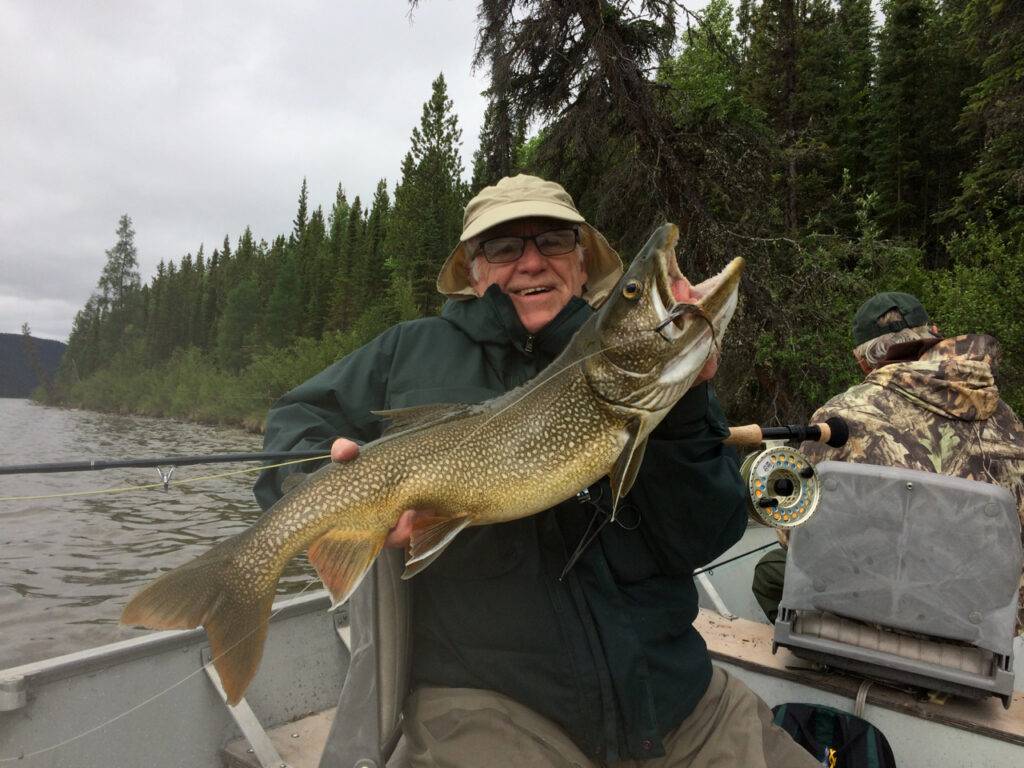
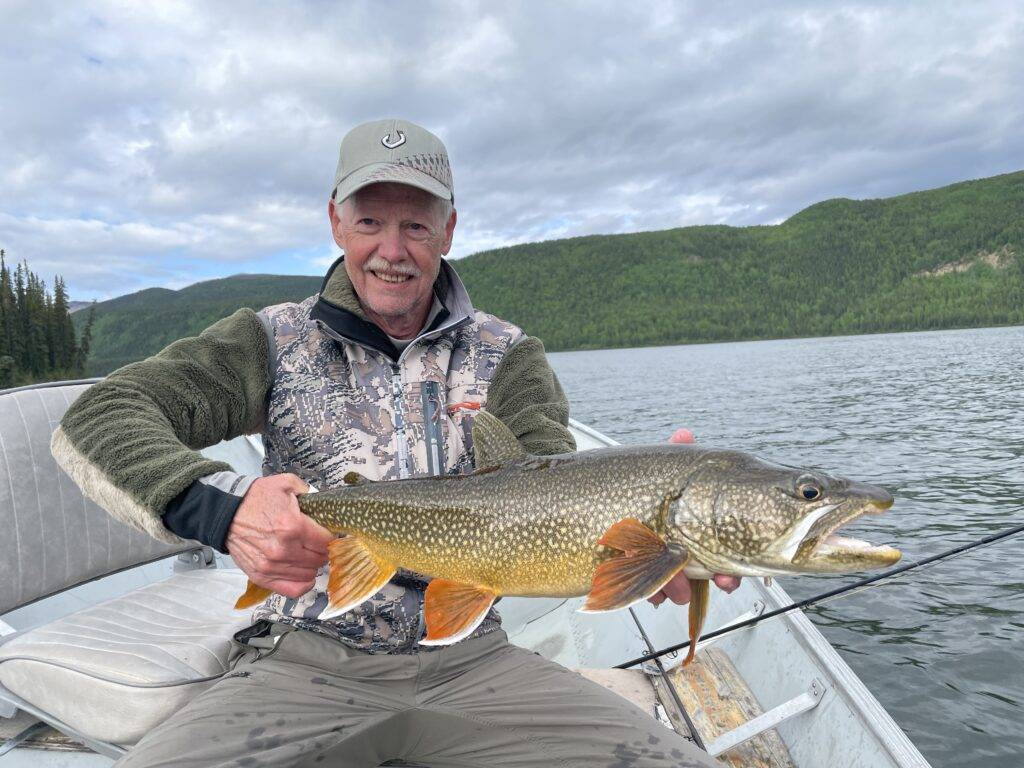
New Information on Where and When Lake Trout Spawn
Until recently, biologists thought that lake trout always spawned over shallow gravel shoals or reefs during the fall; this is only sometimes the case. New technology is proving old theories wrong, for example, in a recent study researchers observed trout spawning at depths of 300 feet. This study took place on Lake Superior in June. An underwater vehicle enabled biologists to document trout spawning at these depths.
The latter was a surprising discovery since lake trout usually spawn in shallow water much later in the season.
In the southeast Yukon, trout will begin moving into the shallows once the water starts to cool, usually by September. By that time, the surface water temperature has fallen into the low 50s. These lower temperatures trigger the spawn.
Female trout become sexually mature at approximately seven years of age. The larger females lay more eggs than smaller fish. A single large female can lay up to 30,000 eggs during the spawn. For this reason, it’s crucial to release the large females and keep only the smaller fish.
From Fry to Adulthood, What Lake Trout Eat.
Wild lake trout fry will begin feeding at least to some extent within two weeks of hatching. A study on Lake Champlain showed that lake trout fry would start feeding even before their yolk sac had been absorbed entirely. In this early stage, their diet consists of zooplankton, freshwater copepod, and insect larvae.
Lake trout fry mature quickly; by the time they reach the juvenile stage, their diet will include terrestrial insects, sculpins, alewives, and other small fish.
Adult Lake Trout are Predator Fish
Adult trout are apex predators. Other fish make up the majority of their diet. Ciscoes, whitefish, suckers, and sculpins are favorites in our waters. Trout will also eat small mammals and even birds when the opportunity arises.
Chironomids may be one of the most important food sources for lake trout during all stages of their lives. Chironomids are abundant. There are over 5000 species in the world. They begin life as eggs on lake bottoms. In the larvae stage, they build cylinder-shaped cases around themselves. Once mature, they break out and ascend to the surface. When and if they reach the surface, they ditch the pupal shuck and fly to the shorelines to mate. Females will return to the water within a day or so to drop their eggs which sink to the bottom and complete the cycle.
Thanks to a well-known angler and fisheries biologist Brian Chan, we now know that chironomids will suspend a few feet off the bottom as they mature. This maturing process lasts a few days, after which they ascend to the surface to hatch. Their abundance and the fact that they stay near the lake bottom for a few days to mature, undoubtedly makes them a valuable food source for trout.
Understanding the life cycle of chironomids can help anglers locate fish. Here in the Yukon Territory, they will begin to hatch as soon as the lakes are ice-free. Birds like the arctic tern feed on these insects as soon as they reach the surface. Large flocks of terns swooping down to the water surface is a telltale sign that a hatch is on. Other fish that lake trout prey on (like whitefish and ciscoes) feed on chironomids. One of our most productive tactics is targeting locations where we know a hatch is underway.
Finding trout is the first step to catching them
Lake trout thrive in cold, oxygen-rich water. While it’s not possible for an angler to check oxygen levels, a thermometer is a must-have item. Keep in mind that trout will seek out water within a narrow temperature band. They prefer water temperatures between 45F and 54F degrees. We find them most active in water that is between 50F and 54F.
Inflowing streams, springs, and rivers bring cool water, and oxygen into lake systems. Streams also wash a plethora of insects into still waters. This rich food source attracts baitfish and predators alike.
Here in the Yukon, we find inflows most productive later in the season when the water warms up.
We use a surface thermometer, as well a thermometer with a probe so we can get accurate water temperatures down into the water column.
See surface thermometer here.
See thermometers with cable and probe here.
Like most species, lake trout love Structure
Good structure is another important habitat feature. A sonar unit can be helpful in identifying underwater structures. Look for abrupt depth changes. These depth changes indicate any underwater structure and will help you locate fish.
Some of the best structures will be visible to an experienced eye. Shallow shoals, and points of land, jutting out into a lake are two of the best.
Lake Trout will Congregate around Shallow Shoals and break lines
Shoals are nothing more than large shallow areas. They are usually visible to the naked eye, and their edges ( break-lines ) will drop into deep water. Larger shoals will quite often be visible in aerial photographs. Google Earth is a great way to locate them on unfamiliar water.
The break-lines around shoals are the sweet spots you want to target. To identify break-lines look for color changes in the water. Dark blue is the color you are looking for. Shallow water will usually appear green, and be quite easy to identify. The break line will be right where the shallow water drops off. Feeding lake trout will often swim along these break lines hunting for baitfish.

Points and spits are Top Locations to find Lake Trout
Points, or spits of land, that jut out into lakes are another lake trout hot spot. These points almost always extend far out into a lake under the water. Natural currents are disrupted by these underwater points. This causes large underwater eddies to form. Trout will congregate in these sheltered areas to feed and rest.
On windy days target the leeward side of points and spits. The waves will usually break at the shallowest point, giving you a visual reference to work with. It’s not uncommon to find large numbers of trout suspended on the leeward side of these points.
Carl Lindquist, and Joy Vietinghoff once caught and released 32 lake trout in one afternoon on the lee side of a small spit at our upper lake lodge. The area they were targeting was about the size of a tennis court. I was the guide that day, and the action was as hot as it gets.
After more than 30 years of guiding anglers in search of these big fish, I am convinced of two things. Water temperature and structure are the golden keys. Find water that is between 50F and 54F, add some structure, and you will find lake trout.
Spinning rods and reels suitable for lake trout
Even smaller lake trout are savage fighters. I’ve seen 12-pounders snap expensive rods when they spool all the line off of an inferior reel. Before that happens, the client will often look puzzled as he cranks the drag down in a vain attempt to slow the fish. It can happen so fast that I won’t have time to get the boat moving fast enough to save him.
Because of their fighting ability, choosing the right rod and reel combination is essential. The right rod and reel will help the fish as much as the angler. The “best catch and release tactics” section will discuss this further.
Manufacturers etch the power and action of a fishing rod into the rod blank near the handle. As you can imagine, manufacturers build fishing rods for various applications. With so many to choose from, it’s essential to understand the terminology used.
The following information can be used for both baitcasting, and spinning rods.
Action: refers to the flexibility of a given fishing rod. The following are the most common rod action types and how they flex.
Extra fast action rods bend only at the very tip.
Fast action rods bend in the upper third of the rod blank.
Moderate action rods will bend in the upper half of the rod.
Slow-action rods bend in the lower third of the rod above the handle.
Rod Power: This refers to the stiffness or a rod’s resistance to bending. Manufacturers rate their rods from ultra-light up to extra-heavy. Generally speaking, the larger the fish, the stiffer a rod should be.
Lure and line weight are another consideration. A lake trout rod should handle at least a 12 lb line and a 1oz lure.
Although they are less sensitive than a fast-action rod, a heavy or extra heavy, moderate-action rod is our choice for lake trout. Suitable for trolling or casting, a moderate action rod will flex down to the middle of the blank. This extra flex gives anglers an advantage when hard-fighting fish are the target. It is also easier to cast a moderate action rod further.
Two of our Favorite Spinning Rods
Ugly Stik Fishing Rods
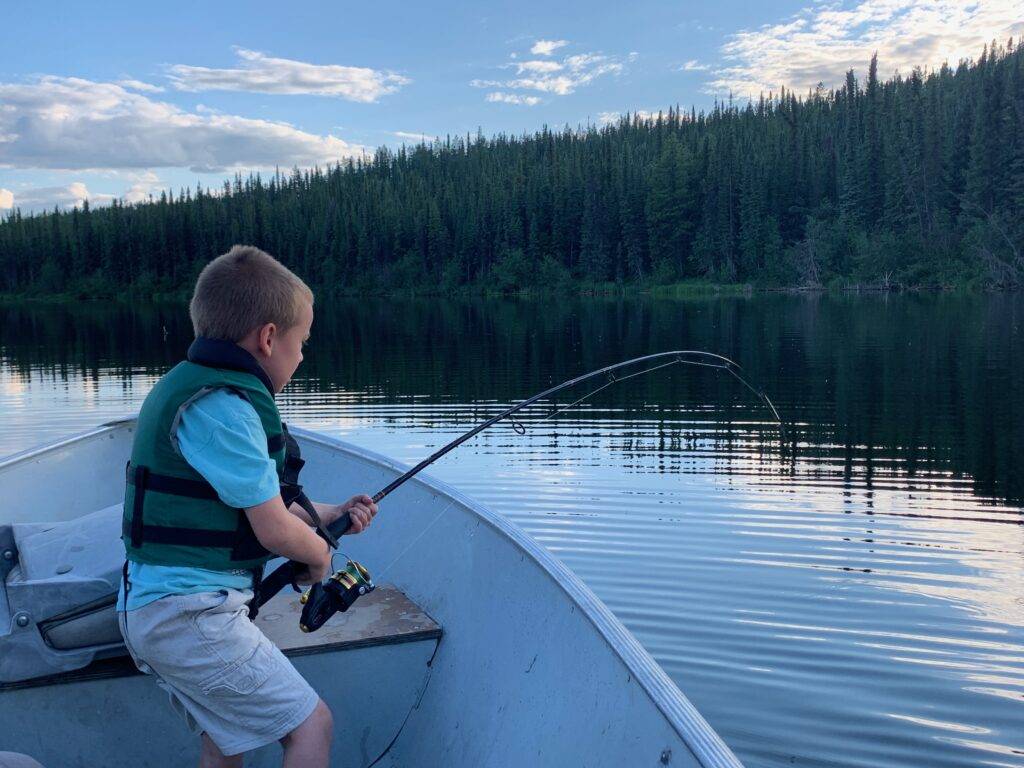
Ugly Stik rods are famous for their durability. A salesman once told me that Ugly Stiks are designed for ugly conditions. I don’t doubt the veracity of that statement because we still use Ugly Stik rods we purchased more than ten years ago. They are not as sensitive as some higher-end rods, but they do the job every time. Ugly Stiks are available in almost any action and power and are reasonably priced. The Tiger Stik Elite makes a fine lake trout or pike rod, and it won’t break the bank.
Temple Fork Outfitters
Lake trout are hard fighting fish that will put your gear to the test. After 30 years in business there are a few brands we have come to trust. Temple Fork Outfitters are one such company. They make top notch fishing gear. Their professional spinning rod is hard to beat when big lakers are on the menu.
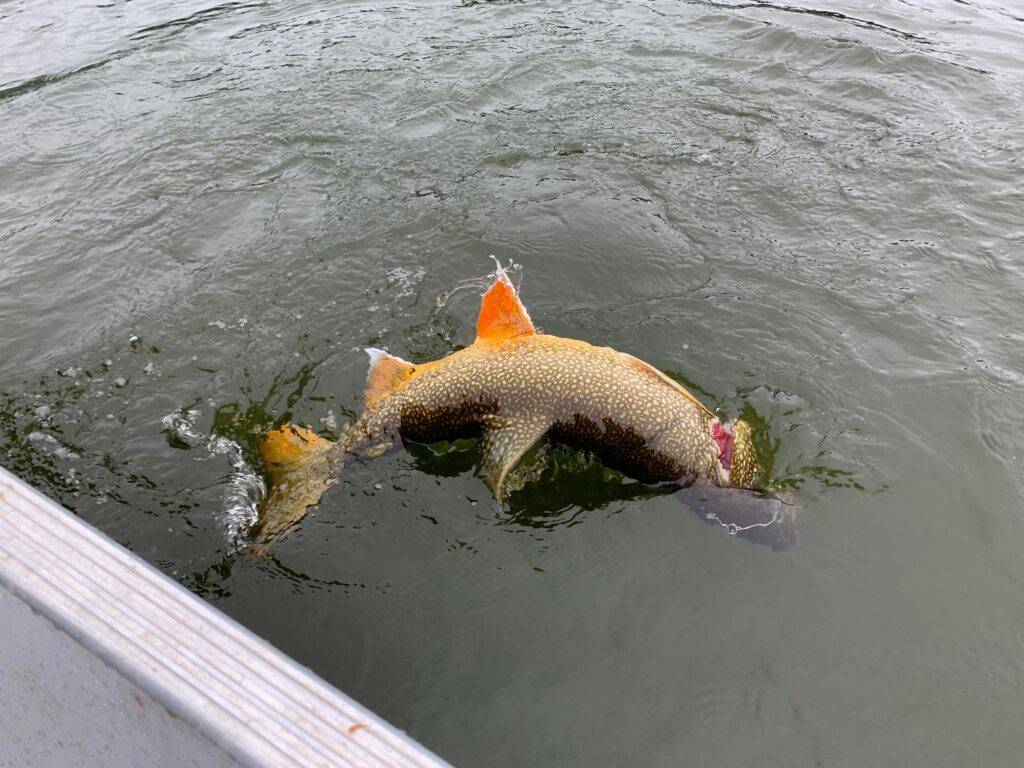

Choose a High-Quality Spinning Reel
So many fishing reels are on the market today that choosing the right one can be confusing. To help narrow your search, consider the following. High-quality fishing reels are expensive, but they are worth every penny. A reel failure is the last thing an angler wants, especially on a fly-in trip where the nearest store is 200 miles away. Lake trout are hard-fighting fish that will give the best reels a workout.
The drag system is the heart of any fishing reel.
This goes for all types of reels. It doesn’t matter how many ball bearings your reel has if the drag can’t slow a fish down.The drag system on most reels uses ‘drag washers’ to create friction against the spool. This is very similar to the brakes on your car. When pressure is applied to the brake pedal, the brake pads are pushed up against the rotor drum creating friction that slows you down—the same thing with fishing reels. One of the ways manufacturers can increase drag is to use larger drag washers. One of the better materials for drag washers is HT-100. There are others, but many high-end reels are using HT-100 for a reason.
The manufacturers we recommend build top-quality fishing reels. They use quality components and have everything a spinning reel should have. Yes, they are expensive, but they will handle the largest trout and last a lifetime.
Visser Spinning Reels
Visser is a name few anglers will recognize. These reels haven’t been on the market very long, but they pack a big punch in the features department. The following features put the Visser squarely on the high end of high-quality spinning reels. A dual Pentium drag system with multiple carbon fiber washers and their unique telescoping bail actuator makes these reels smooth as silk. The gearcase and drag are waterproof, but the solid titanium lip on the spool is what we like about the Visser. The lip on a spinning reel spool takes a beating; the addition of the titanium lip makes it one of the toughest reels you can buy. With 26.5 pounds of drag, the Visser #3 is ideal for anything in northern Canada.
Penn Spinning Reels
These reels need no introduction. Penn has been making top-quality fishing reels for decades. We keep a fleet of Penn reels at Grizzly Creek Lodge for our guests. Some of them are more than ten years old. Any reel that can withstand a decade of use in a commercial setting gets five stars in the durability category. One of our favorite models is the Slammer series.
Bait casting rigs are perfect for hard-fighting lake trout.
Stories about the infamous backlash cause many anglers to steer clear of baitcasting rigs. This is a mistake. A good baitcasting rod and reel, set up correctly, is one of the best rigs an angler can use for big hard, fighting fish like lake trout or pike. The settings might differ from reel to reel, so it’s best to follow the manufacturer’s instructions to set spool and brake tension.
Bait casting reels sit on top of the rod instead of under it like spinning reels do. They utilize a button-type release instead of a bail. This orientation makes precise casting more intuitive. Since the thumb is already over the spool as you release the line to cast, it’s easy to control the amount of line you let out. Keeping an eye on the lure, you can slow the cast as it nears the target. With a little bit of practice, even novice anglers will master the technique. Since lake trout will often sit suspended in a small area along break lines and shoals, the ability to place a lure precisely will make casting more productive.
Baitcasting Rods and Reels That We Use
Temple Fork Outfitters Traveler
This casting rod is a real sleeper. Designed for travel, this 3-piece rod is our top choice and the rod we recommend for fly in trips. With great reviews from anyone who has used them, these rods are as versatile as anything on the market.
St Croix Victory
The St Croix Victory Casting Rod is a high quality rod that handles extremely well. This is one of our top choices when we are casting for trout out along the shoals early in the season.
Lew’s Custom Inshore Baitcasting Reel
Designed for salt water, Lew’s Custom Inshore baitcasting reel is a great choice for lake trout and northern pike. With a one piece aluminum frame and sealed bearings this reel is smooth and durable.
Shimano TRX400
A larger drive and pinion gear give the Shimano TRX400 more cranking power than similar sized reels. Designed to throw or troll big baits for big fish, this reel is fast becoming one of our favorite baitcasting reels.
Choose the correct fishing lines for clear Canadian waters.
Gone are the days when monofilament fishing line was an angler’s only choice.
Today anglers can choose from a variety of fishing lines, and all of them have different characteristics.
You will often hear that things to consider are stretch, strength, abrasion resistance, and memory. Those things are essential, but in the gin clear lakes in northern Canada, how visible a line is underwater is arguably more important than anything else.
Lake trout have excellent eyesight. If trout see something suspicious as they approach your lure, they will avoid it. I’ve watched them move in on a spoon in shallow water only to turn away when they spotted a steel leader.
Fluorocarbon Fishing Line
Compared to all other fishing lines, fluorocarbon wins hands down in the visibility category. It’s almost invisible underwater, even in crystal clear water—fluorocarbon scores high in other areas; it’s strong, sensitive, and abrasive resistant. The only real fly in fluorocarbon’s ointment is that it has too much memory. This memory makes it tangle easily and is unsuitable for spinning reels. It works excellent on baitcasting reels, though.
Braided Fishing Line
A braided fishing line has no memory and, pound for pound, the strongest fishing line you can buy. Made from strands of polyethylene’s braid has zero stretch and is smaller in diameter than other types of fishing lines. The biggest problem with braided lines is that fish can see it easily in clear water. Another issue with braid is that it is so thin it can bury itself into the spool.
Copolymer Fishing Line
Copolymer lines are similar to monofilament lines but better. It isn’t as strong as braid and is more visible underwater than fluorocarbon, but it is still a great line. Copolymer line sinks faster than most other fishing lines, which is a good thing when you target lake trout. Besides the price, you will be hard-pressed to find anyone complaining about copolymer fishing lines.
Monofilament is the oldest of all Line Types
Everyone knows what this line is and probably started fishing with it. Mono is the cheapest fishing line you can buy and also the most popular. That’s saying something with all the competition out there these days. It isn’t the best choice for fish with the stamina lake trout have, though.
The best fishing line for clear northern lakes.
So what’s the best fishing line for lake trout? Copolymer is hard to beat for all-around use, especially on spinning reels.
Braided line is also a solid choice for spinning reels as long as you use at least a 6-foot fluorocarbon leader. Use the improved bristol knot to fasten a fluorocarbon leader to braided line.
For baitcasting reels, fluorocarbon is our top choice.
Our top Producing Spoons, and Deepwater Baits for Lake Trout
Thirty years ago, most of my clients probably thought I was a hoarder. My tackle box overflowed with every lure and bait that caught my eye. Not anymore. Today my tackle box contains a few tools and the hooks I trust. No fluff, nothing extra. The baits I carry have proven to be productive lake trout lures in all water conditions. The top producers are listed below.
Since Dardevle spoons come in an assortment of weights, sizes, and colors, they give anglers an advantage when they need to locate fish. The sizes below enable an angler to target different depths by simply changing spoons.
Dardevle 1 oz.
The one-ounce spoon is our favorite for early-season trout fishing. We use it more than any other spoon. It’s perfect when lake trout are feeding on the shoals and we need to troll or cast over shallow water.
Troll Devle 1 ½ oz.
This is the spoon we use the least. It is useful on the deep side of breaklines early in the season because it does get down a bit deeper than its lighter cousin.
Huskie Junior 2oz.
The Junior is our go-to spoon when the water starts to warm up in July. They also work great on calm, warm days when the lakers like to sit suspended in deeper water off points of land.
Huskie Devle 3 ¼ oz.
The big Huskie Devle is a tremendous deep-water lure. Use it when you think the lake trout have moved out of the shallows. This spoon will get down into the thermocline and is our favorite mid-summer spoon. It works exceptionally well in August when the surface water has warmed up into the 60s.
Colors: The most productive colors for lake trout are red/white, yellow five of diamonds, black/white, and chartreuse/w red spots.
Use Eppinger Dardevle spoons to find lake trout.
A great tactic to use on unfamiliar water is to start with a light spoon and progressively use heavier spoons until you start catching fish. This also works if you don’t know the water temperature and need to find the depth trout are using.
Bondy Baits
If you have yet to hear about the Bondy Bait company, click on the title above and check them out. They might be one of the ugliest baits you have ever seen! The old saying don’t judge a book by its cover applies to these big rubber baits, though, because they flat work.
Their 4oz mini Wobbler is one of their best sellers and the only size we use. This bait is as versatile as anything on the market. The Wobbler can be fished by casting, trolling, or jigging. The Mini Wobbler is about the same size as the ciscoes that lake trout feed on, so I suspect that’s one reason they are so effective. There are better choices for shallow-water fishing, but when the trout are in deeper water, these baits are as good as anything we have ever used.
T60-Flatfish
A who’s who list of the top lake trout lures would only be complete with the T60. Some professional guides refuse to use anything else. The T60-Flatfish earned its bones up in the big water of the Northwest Territories. The problem with this lure is that it’s a one-trick pony.
It runs too deep for shallow water fishing, and although it can be done, only a few anglers enjoy casting a flatfish the size of this brute. Still, it does what it was meant to do and does it well, catch lake trout.
Trolling for Lake Trout
Trolling allows an angler to cover a lot of water quickly. Aim for a trolling speed that matches the type of lure or bait you are using. You can’t troll a T60-Flatfish as fast as you can a Dardevle, but I do troll more quickly for trout than other species. Anglers without experience with lake trout will often troll too slowly. I’ve had clients ask me to slow down before. They felt my trolling speed was too fast until we started catching fish. Lake trout are fast, and they are used to chasing their prey.
Set up your trolling pass
One of the most important things we do when trolling for trout is to set up our troll. We don’t just troll around aimlessly, hoping to catch fish. Pick out an area where you think trout might be, and then set up your troll to take your lure directly through that spot. Quite often, this means short passes. Feel free to reel in and go back through an area several times.
Trout will often sit suspended in a small area. You could easily miss fish if you don’t set up your trolling pass right. Just last summer, I saw an excellent example of this. We were casting flies for trout suspended on the leeward side of a significant point of land. The fish were suspended in about 15 feet of water right on the tip of the underwater point. When we placed our flies directly over that point, we hooked up every time. We wouldn’t get a strike if we were off by just a few feet.
Lake Trout use their body to Stun their Prey.
Something that catches a lot of anglers off guard is how a lake trout will bump a lure.
When hunting, trout will stun their prey before they bite. They do this by bumping into baitfish with the side of their body, or they will slap them with their tail. I’ve watched them do it many times in shallow water. They will slam into your spoon from the side to stun it. When that doesn’t work, they will hit it again. This bump will feel hard, like your lure touched bottom for a second. Quite often, you will feel multiple bumps before you ever get a strike.
Bucktail and tube jigs are all you will ever need for lake trout.
Lake trout jigs should weigh between two and four ounces.
Bucktail jigs: Best for casting
Two to four-ounce, common banana or ultra minnow style.
Tube Jigs: Best for vertical jigging.
We make our tube jigs with a three-ounce inline sinker and a 5-inch Jumbo Jelly tube. These jigs are simple to make and very effective. To build tube jigs, install a #1 barbless treble hook on one end of the inline sinker with a split ring. Then slide the inline sinker up into the tube. Tube jigs constructed in this manner are best for vertical jigging.
How to Jig for Lake Trout
There is an old saying among professional fishing guides, “if you want to catch lots of trout, troll or cast with spoons; if you want to catch big lake trout, go jigging.) There is a lot of truth to this; jigs will produce some real giants.
The best time to jig for trout is later in the summer when the water temperatures are at their highest. Lake trout will move into deeper water as the water warms. In the Yukon, this will occur by late August. By this time, the days are getting shorter, and lake trout are putting on fat reserves for the upcoming spawn. They will often feed near the bottom throughout the day during this period.
In addition to showing you fish, using a sonar fish finder will make it easier to pinpoint good locations to jig. Remember that lake trout prefer some form of structure. The current of larger inflowing streams will sometimes create underwater bowls on the lake bottom. These bowls make excellent lake trout habitats.
Vertical Jigging
Logs, stumps, and other debris are washed into inflow areas during runoff each spring. Vertical jigs shine in these conditions. Since you fish them straight up through the water column, there is less chance of getting snagged.
Fishing a vertical jig is easy; drop it over the side of the boat and let it go to the bottom. When it hits bottom, reel up a foot or so of line and start jigging. The idea is to pull the jig straight up with the tip of your rod. Don’t get your rod tip too high above the water, or it will be hard to set the hook. Lake trout will almost always hit a jig as it’s falling back toward the bottom; a short upward pull will help set the hook.
Fishing a bucktail jig
We use a bucktail jig when the trout feed near the bottom later in the season. Areas that get our attention during this time of year are underwater channels and deep bays.
To fish a bucktail:
1. Cast it out and let it fall to the bottom.
2. When you start the retrieve, use the rod’s tip and jerk the jig forwards a few feet. This jerking motion will cause the jig to jump off the bottom and move forward a few feet before settling back to the bottom.
3. Use the same technique throughout the retrieval.
This tactic allows you to cover more water.
Use bucktail jigs whenever you need to cover a larger area.
Use tube jigs when you are fishing around a lot of underwater obstacles.
Fly Fishing for Lake Trout
p

We’ve been chasing lakers with a fly rod here at Grizzly Creek Lodge since before it was cool. I won’t go so far as to say we were the first lodge to do it, but we were indeed among the first. No one was talking about it back then, that’s for sure. We started doing it because we thought it would be fun. Little did we know that it was not only fun but also highly productive. We still run into many experienced flyfishers who are unaware that it’s possible.
When anglers think about lake trout, they think of deep water and heavy gear, not flies. The truth is that when trout are in the shallows, nothing beats a fly rod and a big streamer. The action is often spectacular, especially early in the season. A few years ago, one of our clients used a stopwatch throughout the day to see how often he hooked up. The longest he went between fish was three minutes.
A successful fly fishing trip for lake trout depends on location and timing. Look for places with lots of structure; this can be harder to find, and fish, on big deepwater lakes. The first three weeks after ice out is the best time to chase lakers with a fly rod. The water temperatures will be cold, and trout will spend most of their time in the shallows. You can catch them later in the season, but the action will be at its best in the spring.
Fishing Chironomids for Lake Trout
Fishing chironomids for lake trout is a relatively new tactic for most fly fishers. However, a few anglers have taken advantage of the chironomid hatch for at least a decade. Well-known fisheries biologist and fly fisher Brian Chan is one of those anglers.
Chironomids are an essential food source for lake trout. How important they are to specific populations has yet to be determined. They are likely very important in cold water bodies. I say this because water temperature plays a significant role in the chironomid hatch.
The most abundant hatches will occur when the water is between 40-50 degrees Fahrenheit. Along with water temperatures, birds are also a good indicator that a hatch is underway. Here in the southeast Yukon, arctic terns feed heavily on chironomids. When we see tern flocks circling over the lake’s surface, we know that a hatch is underway.
It’s been our experience that fly anglers should concentrate their efforts over muddy bottoms with water depths of 25 to 30 feet. Chironomids hatch in the muddy bottoms and stage a few feet off the bottom for a day or so as they mature. Although lake trout will feed on them throughout the water column, they feed most heavily during the staging process near the bottom.
The most productive method to fish chironomids is using an indicator. A floating line and fluorocarbon leader work best for an indicator rig. We use sonar to get the water depth and then set our indicator so the fly will sit about two feet off the bottom. Some fly fishers will use a small split shot to get their fly down. However, a fluorocarbon leader sinks fast enough that a split shot is usually unnecessary.
To fish a chironomid, cast it out over the area you want to fish and let it sink. Once the fly has settled, keep your rod tip pointed at the water and give a short twitch every few seconds.
You will know when lake trout are feeding heavily on chironomids because you will quickly get a lot of strikes.

Fly Rods For Lake trout Start at 8wt
Quality fly rods are expensive. Transportation is not something the salesman will bring up, but it’s something a fly fisher who plans on traveling should consider. Anyone who has ever fished a remote Canadian fishing lodge knows what I’m talking about. Bush planes are small, and pilots get annoyed trying to stuff long cases in what little cargo space they have left. Do yourself a favor and only take four-piece fly rods on fly-in trips.
My favorite fly rod for lake trout is an 8wt Drifter manufactured by Moonshine Rod Company. Good fly rods for lake trout start at 8wt. A 9 or 10wt is fine too. There are a lot of good fly rods on the market today. One of the things that swung me towards the Drifter was that it comes standard with an extra tip section. That’s a real bonus on a remote fly-in fishing trip.
Moonshine Rod Company

On of my favorite fly rods for lake trout is an 8wt Drifter II manufactured by Moonshine Rod Company. Good fly rods for lake trout start at 8wt. A 9 or 10wt is fine too. There are a lot of good fly rods on the market today. One of the things that swung me towards the Drifter was that it comes standard with an extra tip section. That’s a real bonus on a remote fly-in fishing trip.
Our Top Two Producing Patterns For Lake Trout
The clouser minnow, and the rabbit fur strip leach like those on the right have proven to be our top producing lake trout patterns. If I could have only two patterns, I would choose these two, they are that good.
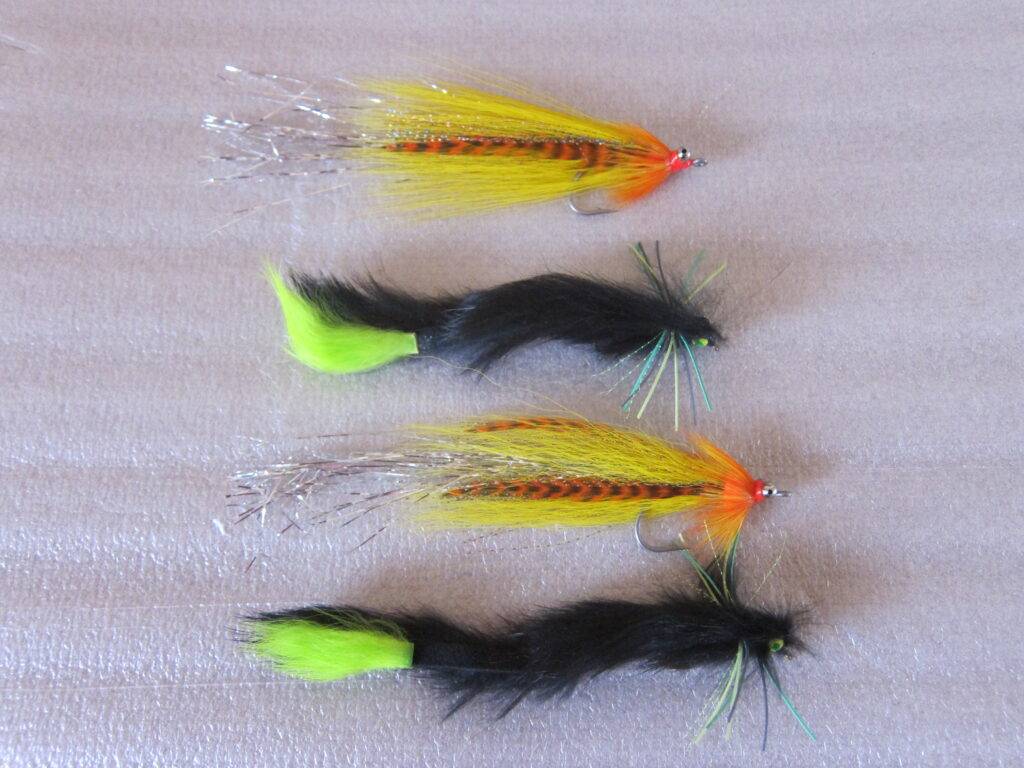
Check out our blog to learn more about fly fishing for lake trout. You can see it here
Fly Lines and Leaders you Should Have For Lake Trout
Three types of fly lines are helpful for lake trout fishing. It is important to remember that water temperatures will play a significant role in the kind of fly line most productive on a given day.
Sink Tip:
A sink-tip fly line is what it sounds like; the body of the line floats, and the tip portion of the line sinks. This type of line has variations, and some will sink faster than others. An intermediate sink tip is the bread and butter fly line for lake trout. We use it more than any other line. I prefer a shooting head sink tip because it makes it easier for me to cast big heavy flies, especially into the wind. Choose an intermediate line with a sink rate between 3-6 inches per second. This sink rate works well when the surface temperatures are cold, and the trout are working the shallows.
Sinking Fly Line:
As you might expect, a full sink-fly line sinks. Again there are variations of full sink fly lines and how fast they sink. Most manufacturers use a number system to describe how fast a given line sinks. The number represents ( Inches per second), so a sink 2 fly line will sink at a rate of two inches per second. A sink 3 line will sink at a rate of three inches per second, and so on. For lake trout, I prefer a fast sinking line. It will get a pattern down where I need it much faster.
Floating Fly Lines:
Floating lines have only one application when it comes to fly fishing for lake trout, and that’s when you are fishing chironomids. Since an indicator is used in this type of fishing, a floating line is needed. We will discuss this more in the next section.
Leaders and Tippets
Since fluorocarbon is resistant to abrasions and almost invisible underwater, it is the best material for fly fishing leaders in clear water. DIY fly fishers can make their own leaders using the 60/20/20 formula. This formula works like this: 60 percent of the leader is the butt, 20 percent is the middle, and 20 percent is the tippet. There are so many good leaders on the market these days that we usually buy premade leaders. Sizes 0X up to 02X are best for lake trout.
Catch and Release Techniques That will Improve Mortality Rates
Mortality rates of released fish are something every angler should take seriously. Good catch and release techniques can reduce mortality rates to almost zero. Lake trout grow slowly in our cold northern waters, so properly handling these fish is especially important.
Sustainability has always been our number one priority. With that goal in mind, a good catch-and-release policy was a big part of our business plan. Now 30 years later, we know that our catch-and-release tactics work.
Our catch-and-release methods differ from other lodges. One of the things that we do differently is limit the use of nets. I could write an entire blog post on fish slime (and maybe someday I will because it is a vital part of fishing, and not many anglers understand how it effects fish mortality rates.)
Fish Slime is Part of Their Immune System and Should be Protected
Anyway, back to fish slime. The slimy coating you feel on a fish’s body is part of its immune system. It protects them from all sorts of things, just like our immune system protects us. The last thing we want to do is disturb that layer of slime. That’s the number one reason we rarely use a net.
Rubber nets are better than old nylon nets, but it is still not ideal for a lake trout to be rolling around in a net. Think back to the last time you used a net and how slimy the netting felt after removing the fish. That’s the slime you need to protect.
We will use and recommend you use a net for two reasons. The first is to weigh a fish, and the second is when a fish is hooked deep, and you need to stabilize the fish to remove the hook.
If you insist on weighing a fish ( we recommend using the length-to-weight formula), do it while it is in a net. The old way of weighing fish by the lip is the worst thing you can do. Weighing a fish in this manner puts tremendous strain on the neck gill area and should be avoided. The use of barbless hooks is much easier on both fish and anglers. With barbless hooks, we rarely see a fish hooked deeply.
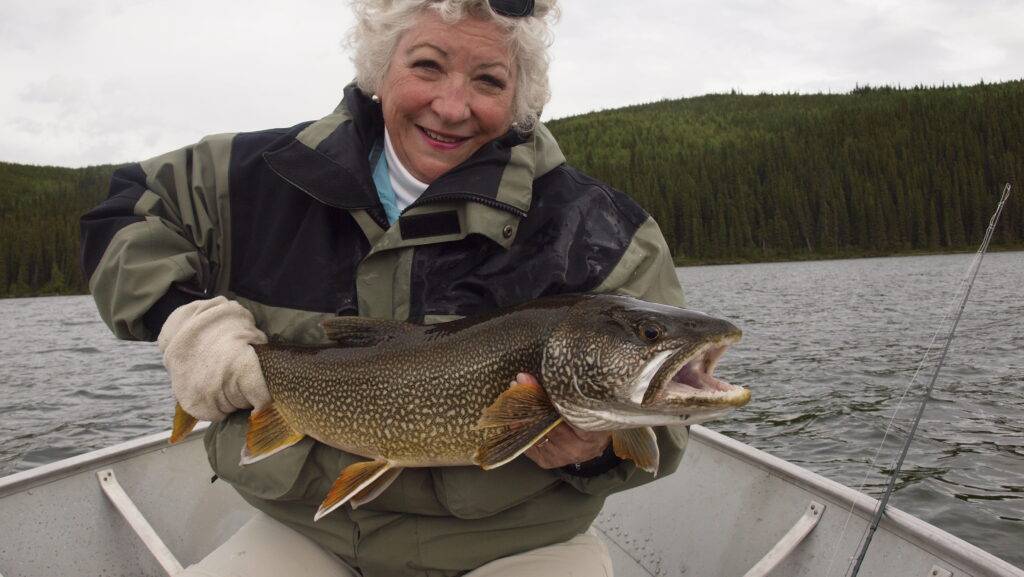
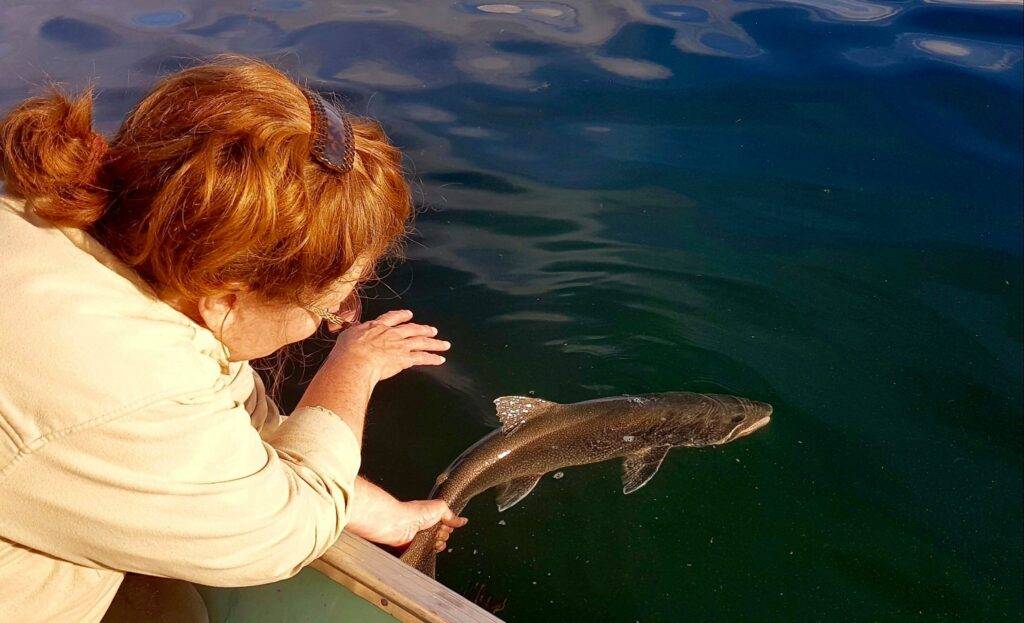
At Grizzly Creek Lodge, our catch-and-release policy works like this. The angler brings the fish up alongside the boat, and we use a pair of pliers to grab the hook’s shank. A quick twist and the fish is released, never having been touched.
We measure large fish the same way. Once they are alongside the boat, we use a cloth seamstress tape to measure them without ever taking them out of the water.
We only handle fish when we want to get pictures and then use the ‘tailing’ method. As the fish comes alongside the boat, we will grab it just in front of the tail. Make sure your hands are wet before you do this, ( a wet cotton glove works great too). With a firm grip on the tail, slide your other hand under the area behind the gills. Then you can lift the fish straight out of the water for photographs.
We do it carefully when we put the fish back in the water. Let the fish sit submerged for a few seconds before you release your grip.
Prior to the Industrialization of North America Lake Trout were an Important Food Source for Indigenous and Non-Indigenous Alike
Lake trout is a nutritious food source, high in protein and omega three fatty acids. These fish were an important food source for both indigenous and non-indigenous people. This was especially true for interior populations that didn’t have access to migrating salmon. Harvest methods included netting, fish traps, spearing, snaring, and fishing with hooks.
Our Favorite Lake Trout Recipes
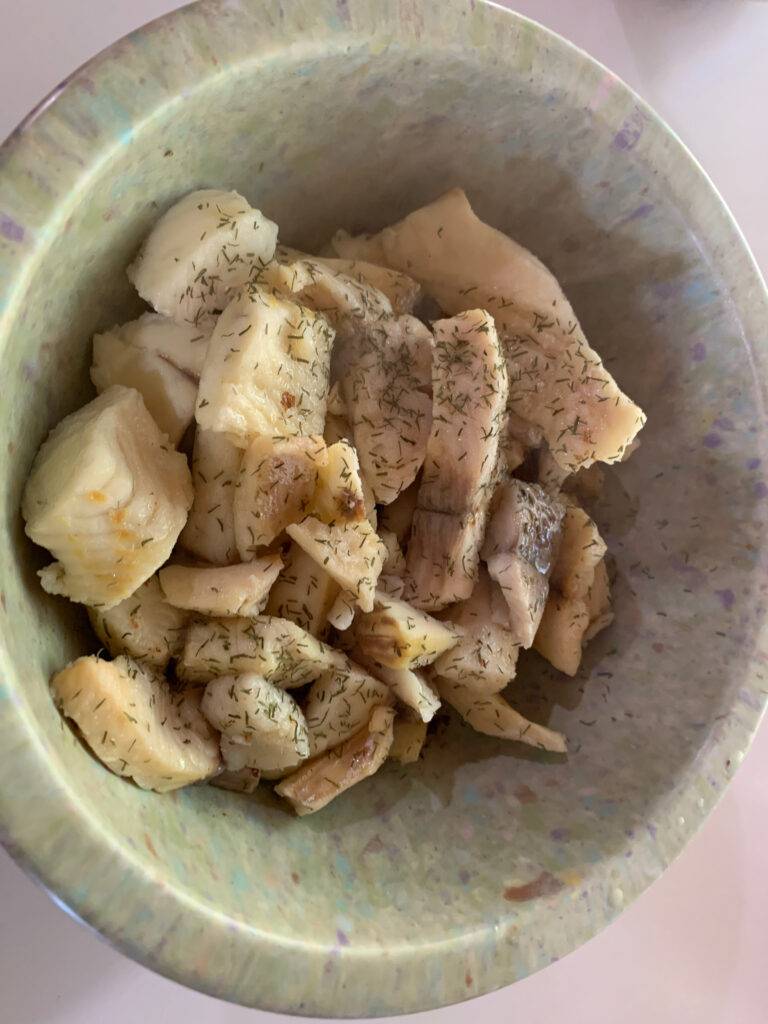
- This Recipe is called “Poor mans Lobster” by local First Nations People
- Cut lake trout fillets into narrow strips
- Put 1/2 cup salt into 8-cups boiling water
- Carefully put lake trout strips into boiling salt water
- Cook three minutes / drain and sprinkle with dill
- Drizzle with melted butter and serve
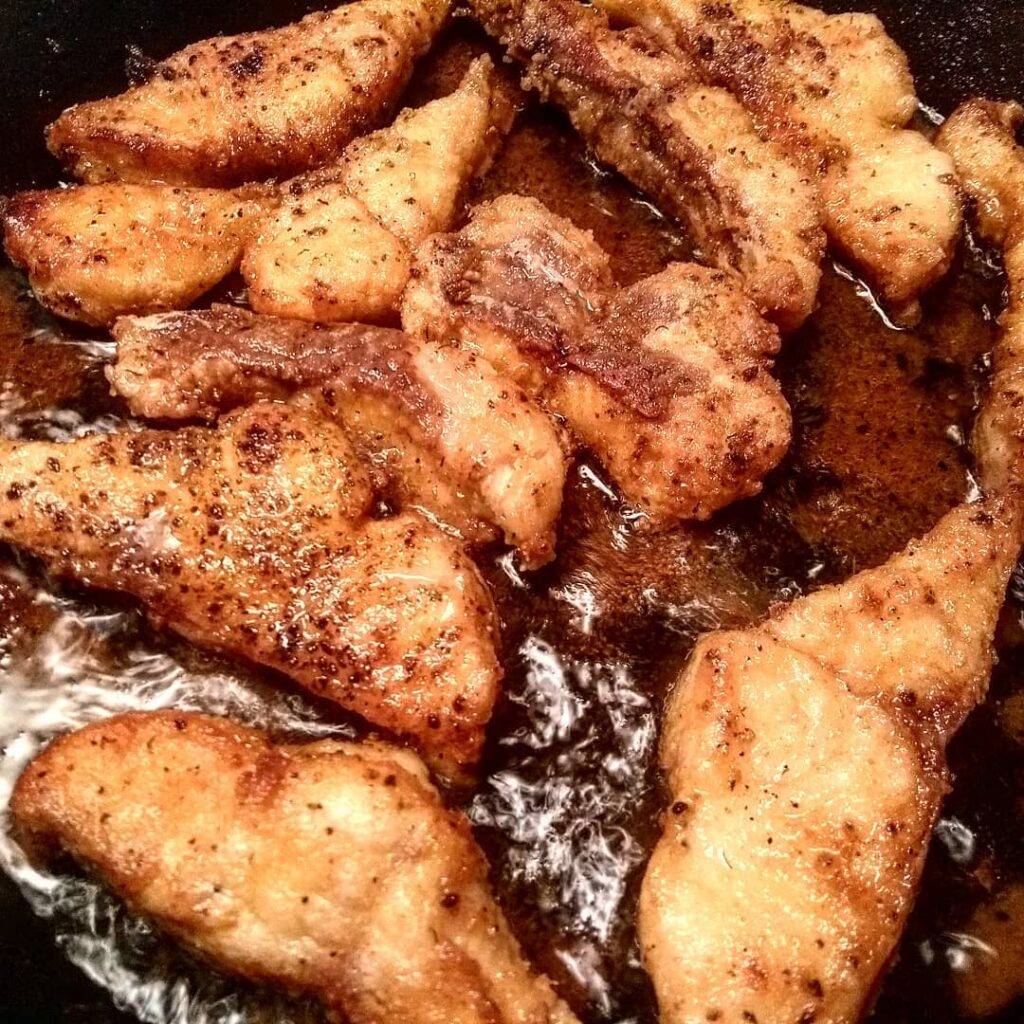
- Fried Lake Trout. This is one of Our Favorite Shore Lunch Recipes
- Fresh lake trout fillets
- One cup white flour
- Two tablespoons Hys Seasoning salt
- One tablespoon Mrs Dash seasoning
- Mix flour and spices thoroughly
- Coat fillets with flour/spice mixture. ( Zip Lock bag works great)
- Fry in hot grease over an open fire
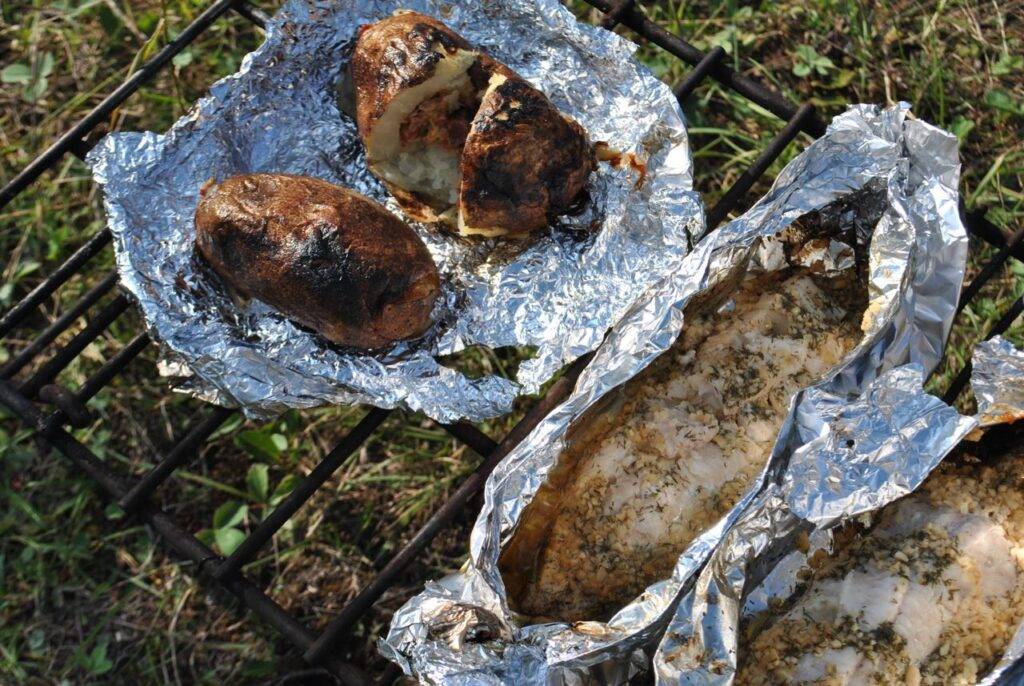
Baked Lake Trout
- Boneless lake trout fillets
- Two tablespoons butter
- Dill, Mrs Dash, salt, and pepper
- Drizzle melted butter over fillets
- Bake in covered pan in the oven or wrapped in tinfoil over a fire
- Cook until fillets flake easily / do not overcook
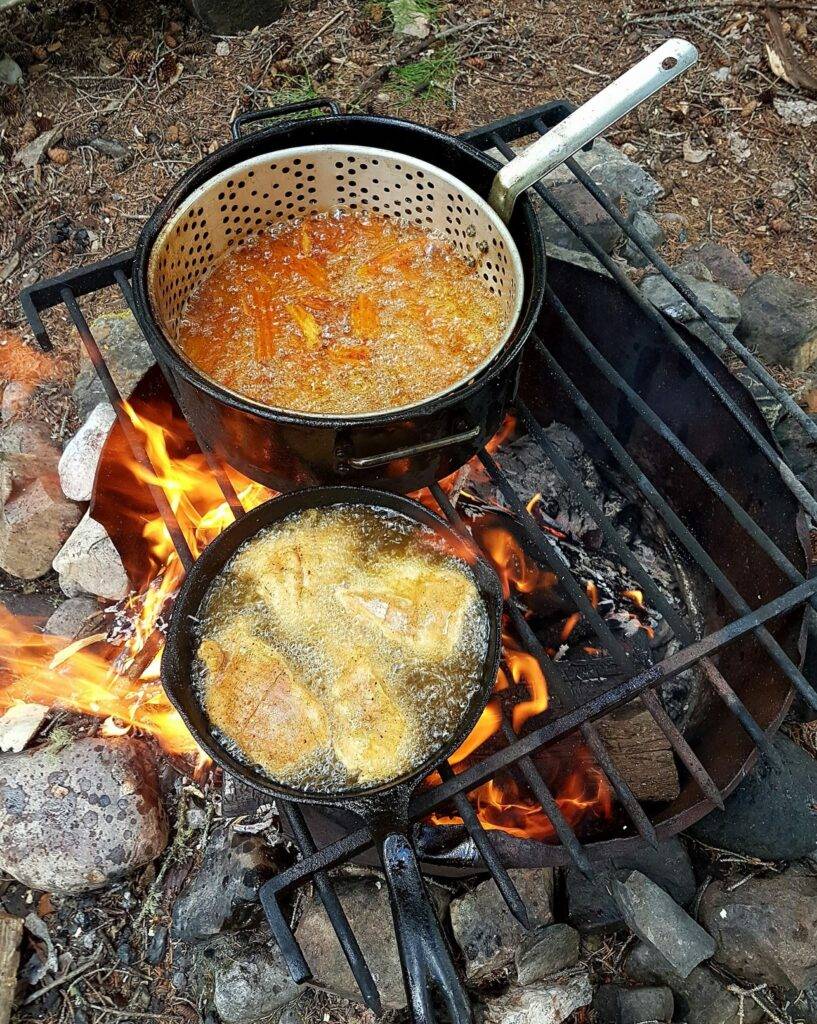
The Bayou Classic pictured on the left makes cooking over an open fire a breeze. We use it for fish, potatoes, or anything else we want to deep fry.
Amazon and the Amazon logo are trademarks of Amazon.com, Inc, or its affiliates.